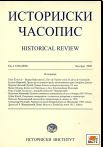Градина - Казновиће, резултати археолошких истраживања
Gradina-Kazanoviće, Results of Archeological Research
Author(s): Dejan BulićSubject(s): History
Published by: Istorijski institut, Beograd
Keywords: Raška; gradina; fort; Early Byzantium; Middle Ages; ceramics
Summary/Abstract: One of the last researched localities in the Ibar valley is Gradina- Kazanoviće, in the municipality of Raška. The only access to the site was through a slope, from the peak of Dubovi. There was probably a tower at the entrance, and a dry ditch right before it. Although it was only slightly away from the main communication route along the Ibar, higher hills in the background made the site hidden, and provided security for its population. Such a location made the site unnoticeable even from some surrounding Early Byzantine localities. The citadel was explored with five exploratory probes, and the approximate oval base, 123 meters in length, was established based on the noted wall parties and their superficial covering, while in some parts of the site the previous fortification manifested as a layer of scattered rock. The measured width of the south wall at the former entrance was 1.8 m. Broken rock tied by stucco plaster was used for construction, and the funding of the walls was done on the live rock. The recovered archeological material indicate that this is a two-layered archeological site. The construction took place in the Early Byzantine period, in the 6th century, and the space was also used during 9th and 10th centuries. The main criteria for dating is provided by the ceramics. Specimens belonging to the earlier horizon, based on analogies with nearby localities around Raška, Novi Pazar, Sjenica, and Tutin, could be dated to late 6th and early 7th century. In mid-9th century, the frontier between Serbia and Bulgaria was around Ras, which indicates that the border of Serbia at the time went northwards following the Ibar, and our fort would have been on Bulgarian territory. However, there could have been some shifts in the border, either during the reign of Časlav, or during the 10th century, following the establishment of catepanate in Ras, between 971 and 976, when Serbs regained their independence. Regardless of in whose territory it was located, as a frontier outpost, the site would have been useful during the Simeon's conquest of Serbia in 926, during the establishment of the catepanate, or during Samuil's conquests.
Journal: Историјски часопис
- Issue Year: 2007
- Issue No: 55
- Page Range: 45-62
- Page Count: 8
- Language: Serbian

